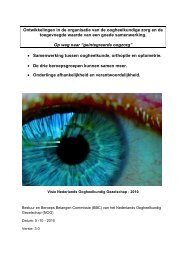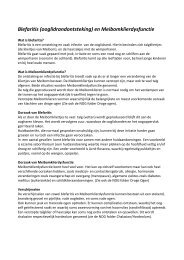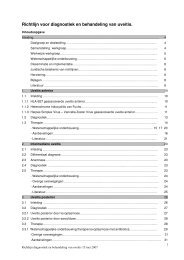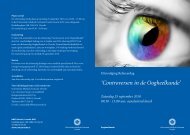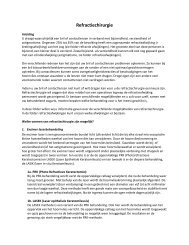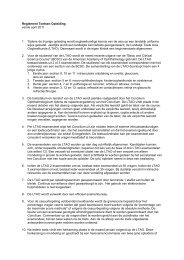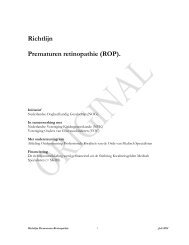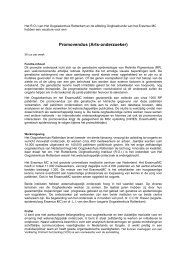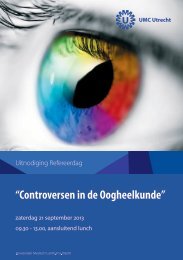terminology and guidelines for glaucoma ii - Kwaliteitskoepel
terminology and guidelines for glaucoma ii - Kwaliteitskoepel
terminology and guidelines for glaucoma ii - Kwaliteitskoepel
You also want an ePaper? Increase the reach of your titles
YUMPU automatically turns print PDFs into web optimized ePapers that Google loves.
adrenergic antagonists. Based on preliminary clinical data, bimatoprost, latanoprost, <strong>and</strong> travoprost appear to be at<br />
least as effective on IOP as timolol, while the effectiveness of unoprostone is similar or slightly less.<br />
Prostagl<strong>and</strong>in analogues/prostamide may be used in conjunction with other anti<strong>glaucoma</strong> medications, although<br />
further studies must establish the optimal combinations. Whether clinical experience will yield outcomes in favour of<br />
one of these products remains to be determined. Patients should be educated on associated adverse events especially<br />
pigmentation of the iris <strong>and</strong> eyelashes.<br />
Major contraindications<br />
Known hypersensitivity to bimatoprost / latanoprost / travoprost / unoprostone, benzalkonium chloride, or any<br />
other product ingredient.<br />
Patients should not administer these drugs while wearing contact lenses, but contact lenses can be reinserted 15<br />
minutes following administration of the drugs.<br />
Precautions Cystoid macular edema in aphakes/pseudophakes has been reported in few cases, most occurring in<br />
aphakic patients, in pseudophakic patients with a posterior lens capsule rupture, or in patients with<br />
known risk factors <strong>for</strong> macular edema 69,70 .<br />
Bimatoprost, latanoprost, travoprost <strong>and</strong> unoprostone should be used with caution in these patients<br />
although con current administration of nonsteroidal anti-inflammatory agents, such as diclofenac,<br />
might decrease this side effect<br />
Unilateral treatment may cause a difference in iris colour <strong>and</strong> in length, thickness, pigmentation, <strong>and</strong><br />
number of lashes between the eyes.<br />
Patients with uveitis.<br />
Side effects<br />
Local:<br />
Conjunctival hyperemia (Bimatoprost up to 44.7% 53 ,Latanoprost up to 27.6% 55 , Travoprost up to<br />
49.5% 55 , Unoprostone up to 9% 61 ), burning <strong>and</strong> stinging, <strong>for</strong>eign body sensation <strong>and</strong> itching.<br />
Hyperemia is often transient <strong>and</strong> usually mild, without associated symptoms.<br />
Eyelash changes (increased length, thickness, pigmentation, <strong>and</strong> number of lashes), reversible after cessation<br />
of medication 52-58,65 .<br />
Increased iris pigmentation, especially seen in patients with green-brown, blue/gray-brown or yellowbrown<br />
irides. The long-term effects on the iris or other parts of the eye are currently unknown. This<br />
effect is to be considered permanent 62-64 . Unoprostone is less likely to change iris color.<br />
Cystoid macular edema in aphakes/pseudophakes has been reported in few cases, most occurring in<br />
aphakic patients, in pseudophakic patients with a posterior lens capsule rupture, or in patients with<br />
known risk factors <strong>for</strong> macular edema 69,70 .<br />
Reactivation of herpes keratitis 66,67 .<br />
Anterior uveitis 68 .<br />
Systemic: The following events have been identified during postmarketing use of prostagl<strong>and</strong>in analogues in clinical<br />
practice. Because they are reported voluntarily from a population of unknown size, estimates of<br />
frequency cannot be made.The events include: dyspnea, asthma <strong>and</strong> exacerbation of asthma.<br />
Prostagl<strong>and</strong>in derivatives <strong>and</strong> prostamides appears to have very few systemic side effects in comparison<br />
with β blockers <strong>and</strong> selective α2 agonists 71-73 .<br />
Pregnancy <strong>and</strong> nursing mothers<br />
There are no adequate <strong>and</strong> well controlled studies in pregnant women. Only to be used during pregnancy if potential<br />
benefit justifies the potential risk to the fetus.<br />
It is not known whether the drugs or their metabolites are excreted in human milk.<br />
Ch. 3 - 19 EGS



